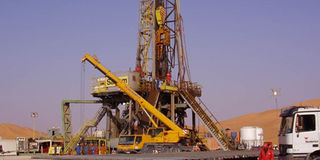Forum heralds new dawn for region

Oil drilling in northern Kenya. PHOTO/FILE.
What you need to know:
- With the new oil and gas discoveries, there is a need for a sustained public discourse on the most prudent ways of utilising the precious resources in Kenya.
- The oil and gas resources in Kenya present a great opportunity to sustain high rates of growth in the East African region and accelerate job creation.
Between Wednesday and Friday, delegates from different parts of the world converge on the University of Nairobi to deliberate on the opportunities for capacity building in the oil and gas sub-sector and other extractives in the larger eastern African region.
Organised by Kenya Pipeline Company (KPC)-owned Morendat Institute of Oil and Gas (MIOG) with delegates drawn from Canada, Australia, Nigeria, Tanzania, Uganda and Kenya, among other countries, the conference aims at triggering a regional conversation on the best avenues to build capacity for the nascent sub-sector as the host country is about to join the oil producers club.
With the new oil and gas discoveries, there is a need for a sustained public discourse on the most prudent ways of utilising the precious resources in Kenya and the region to transform the lives of the people.
RECENT DISCOVERIES
Recent discoveries of oil and gas reserves in eastern Africa — specifically in Kenya, Uganda, Tanzania and Mozambique — have the potential to transform these economies to scale new heights. Studies show that East Africa’s growth pattern makes the region the most attractive on the continent. This demonstrates the countries’ resilience in the face of global economic adversity despite threats such as lower oil and commodity prices and political uncertainties that could affect growth.
If well managed, these resources could be fundamental in meeting the huge infrastructural deficits that characterise the region and, indeed, the continent. The resources could form the basis for agricultural transformation and also investments in key aspects of human capital, such as education and health.
JOB CREATION
The oil and gas resources in Kenya, therefore, present a great opportunity to sustain high rates of growth in the region and accelerate job creation in line with President Uhuru Kenyatta’s ‘Big Four’ agenda — namely; manufacturing, universal healthcare, food security and affordable housing.
However, this potential cannot be exploited when Kenya still imports pipeline welders and coaters. Lack of requisite skills for the sub-sector remains a major challenge as the country and the region prepare to exploit the newfound oil and gas resources.
This, together with other challenges such as lack of adequate oil and gas infrastructure and the high cost of capital required to set up the necessary technology, are some of the issues the conference will address.
KPC is the only white pipeline operator in the region with a 1,800-kilometre network. But as the region embarks on large-scale oil and gas exploitation, experts estimate that over 2,700km of pipelines will be developed to coincide with this significant growth.
GAS TECHNICIANS
This will require over 2,800 oil and gas technicians, up from the 700 in the region, all of whom work at KPC.
These demand dynamics are what MIOG seeks to address to build human resource base in the region to manage, operate and maintain oil and gas pipelines.
The region must moot proactive sector strategies and programmes; a focused and sustained public discourse on the opportunities and challenges that come with the discovery of oil and gas reserves in our backyard must now begin.
The conference is one such avenue through which governments, the private sector, donors, international community and, above all, the host communities for the natural resources, can be empowered with the right information to avoid the ‘resource curse’ where oil and gas revenues lead to instability, poverty and corruption.
CRITICAL
With these glaring sector gaps, three questions remain critical: How do we prudently utilise the oil and gas resources? How does Kenya position itself strategically for economic prosperity, given this discovery? Do we have an adequate human resource base for this emerging sector?
To address the skills gap in the sector, KPC set up MIOG in 2016 with the aim of developing human resource capacity for partner states in oil and gas pipelines management, as well as operations and maintenance, to reduce dependence on expatriate human resource.
LOCAL CONTENT
MIOG is a local training school that draws students from across East Africa with the aim of building local capacity for future assignments, in line with government policy of promoting local content.
The problem of skills gap and mismatch has been denying Kenya a big portion of mega projects with most of our young people confined to menial labour. The school will not only prepare them for the future and help reaffirm the country’s status as a new player in oil and gas trade but also build human resource capacity in the neighbouring countries.
Dr Jonah Aiyabei is the director, Morendat Institute of Oil & Gas. [email protected]





